Table of Contents
Gauss’s Law is a fundamental concept in physics that helps us understand electric fields and charge distributions. If you’re studying for your CBSE Class 12 exams, mastering this topic is essential. In this introduction, we will discuss important questions related to Gauss’s Law, including various numericals and conceptual questions to help you prepare effectively.
In this section, we’ll cover Gauss law numericals for Class 12, which will challenge your problem-solving skills and deepen your understanding of the topic. You’ll also find questions on Gauss Law for Class 12 that test your grasp of the concepts and their applications. These questions are aligned with the Class 12 syllabus and are designed to help you get the most out of your studies.
Additionally, we will provide links to NCERT Solutions for Class 12 Physics, making it easier for you to find the resources you need to excel.
Download CBSE Class 12 Physics Important Questions 2024-25 PDF
You can download more Important Questions Class 12 Physics Chapter 12 PDF for free from Infinity Learn -Learning App.
| CBSE Class 12 Physics Important Questions | ||
| S.No | Chapter No | Chapter Name |
| 1 | Chapter 1 | Electric Charges and Fields |
| 2 | Chapter 2 | Electrostatic Potential and Capacitance |
| 3 | Chapter 3 | Current Electricity |
| 4 | Chapter 4 | Moving Charges and Magnetism |
| 5 | Chapter 5 | Magnetism And Matter |
| 6 | Chapter 6 | Electromagnetic Induction |
| 7 | Chapter 7 | Alternating Current |
| 8 | Chapter 8 | Electromagnetic Waves |
| 9 | Chapter 9 | Ray Optics and Optical Instruments |
| 10 | Chapter 10 | Wave Optics |
| 11 | Chapter 11 | Dual Nature of Radiation and Matter |
| 12 | Chapter 12 | Atoms |
| 13 | Chapter 13 | Nuclei |
| 14 | Chapter 14 | Semiconductor Electronic: Material, Devices And Simple Circuits |
| 15 | Chapter 15 | Communication System |

Electric Charges and Fields Important Questions for CBSE Class 12 Physics Gauss’s Law
1. Area Vector- The vector associated with every area element of a closed surface is taken to be in the direction of the outward normal.
Consider the diagram given as below.
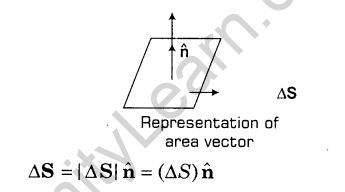
Here, AS is the area vector in the direction of the unit vector n normal to the surface area AS
2.Electric Flux Electric flux linked with any surface is proportional to the total number of electric field lines that normally pass through that surface. It is a scalar quantity.
SI unit of electric flux is N – m2 C-1 or JmC-1 or Vm.
CGS unit of electric flux is dyne – cm2/ stat -C.
Now, consider the electric flux linked with a surface when
Click Here: CBSE Class 12 Physics Syllabus 2024
Previous Year Examination Questions
1 Mark Questions
1.Consider two hollow concentric spheres S1 and S2 enclosing charges 20 and 40 respectively, as shown in the figure, (i) Find out the ratio of the electric flux through them, (ii) How will the electric flux through the spheres S1 change if a medium of dielectric constant er is introduced in the space inside S1 in place of air? Deduce the necessary expression. [All India 2014]
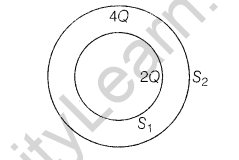
Ans.
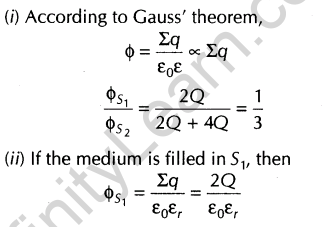
2.Two charges of magnitudes –20 and + O are located at points (a, 0) and (4a, 0), respectively. What is the electric flux due to these charges through a sphere of radius 3a with its centre at the origin? [All India 2013]
Ans.
3. A charge q is placed at the centre of a cube of side L. What is the electric flux passing through each face of the cube? [All India 2010; Foreign 2010]
Ans.
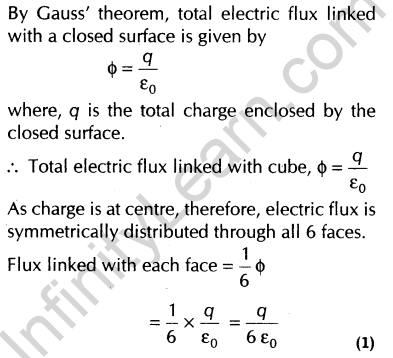
4. Figure shows three point charges,+ 2q, – q and + 3q. Two charges + 2q and – q are enclosed within a surface S. What is the electric flux due to this configuration through the surface S? [Delhi 2010]
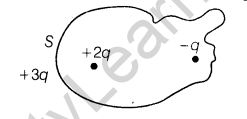
Ans.
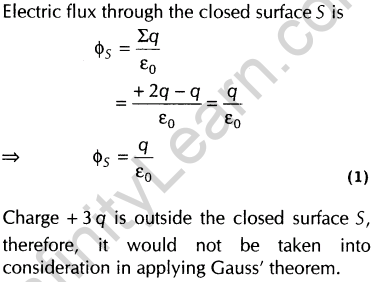
5. If the radius of the Gaussian surface enclosing a charge is halved, how does the electric flux through the Gaussian surface change?[All India 2009,2008]
Ans.Total charge enclosed by the Gaussian surface remains same even when radius is halved. Therefore, total electric flux remains constant as per Gauss’ theorem. There will not be any change in electric flux through the Gaussian surface.
Also Check: CBSE Class 12 Physics Answer Key 2024 | CBSE CBSE Class 12 Physics Paper Analysis 2024
2 Marks Questions
6.Given a uniform electric held E =5 x 103 i N/C, find the flux of this held through a square of 10 cm on a side whose plane is parallel to the YZ-plane. What would be the flux through the same square if the plane makes an angle of 30° with the X-axis? [Delhi 2014]
Ans.
7.Given a uniform electric held E =2 x 103 i N/C, find the flux of this held through a square of side 20 cm, whose plane is parahel to the YZ-plane. What would be the flux through the same square if the plane makes an angle of 30° with the X-axis? [Delhi 2014, HOTS]
Ans.Refer to ans. 6. (Ans 40 Nm2/C)
8.Given a uniform electric held E = 4 x 103 i N/C. Find the flux of this field through a square of 5 cm on a side whose plane is parallel to the YZ-plane. What would be the flux through the same square if the plane makes an angle of 30° with the X-axis? [Delhi 2014, HOTS]
Ans.Refer to ans 6. (Ans. 5 Nm2/C)
9.A sphere St of radius q enclosed a net charge Q. If there is another concentric sphere S2 of radius r2(r2 > q) enclosing charge 20, hnd the ratio of the electric hux through S1 and S2. How will the electric flux through sphere Sj change if a medium of dielectric constant K is introduced in the space inside S2 in place Of air? [All India 2014]

Ans.
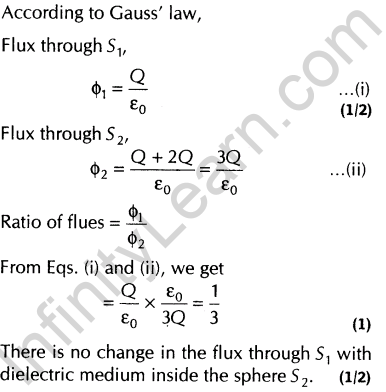
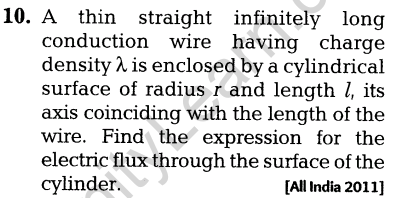
Ans. A thin straight conducting wire will be a uniform linear charge distribution.
Let q charge be enclosed by the cylindrical surface.
11.Two charged conducting spheres of radii rt and r2 connected to each other by a wire. Find the ratio of electric fields at the surfaces of the two spheres. [Delhi 2011 c]
Ans.
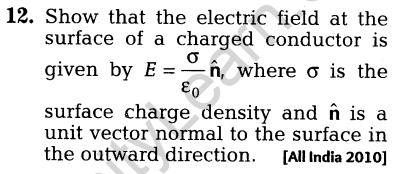
Ans.
13.A spherical conducting shell of inner radius R1 and outer radius R2 has a charge Q. A charge q is placed at the centre of the shell. [All India 2010c]
(i)What is the surface charge density on the (a) inner surface, (b) outer surface of the shell?
(ii)Write the expression for the electric field at a point to x>R2 from the centre of the shell.
Ans.Here, two points are important
(i) Charge resides on the outer surface of spherical conductor (skin effect).
(ii) Equal charge of opposite nature induces in the surface of conductor nearer to source charge.
14.Define electric flux. Write its SI unit. A charge gis enclosed by a spherical surface of radius [All India 2009]
Ans.The total electric flux linked with a surface is equal to the total number of electric lines of force passing through the surface when surface is held normal to the direction of electric field.


15.Draw the shapes of the suitable Gaussian surfaces while applying Gauss’ law to calculate the electric field due to
(i)a uniformly charged long straight wire.
(ii)a uniformly charged infinite plane sheet. [Delhi 2009 C]
Ans. The surface that we choose for application of Gauss’ theorem is called Gaussian surface. We usually choose a spherical Gaussian surface.
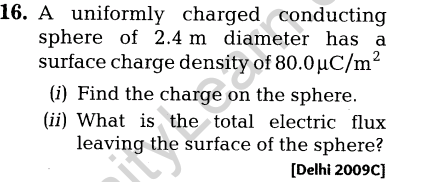
Ans.
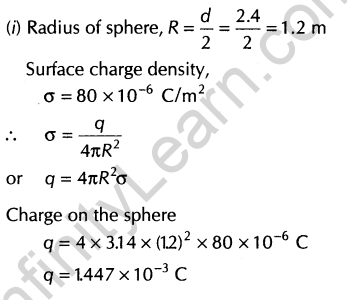

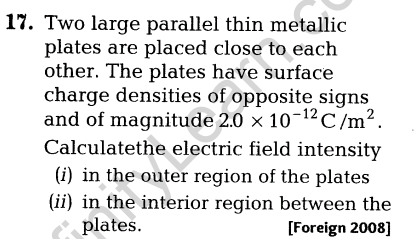
Ans.
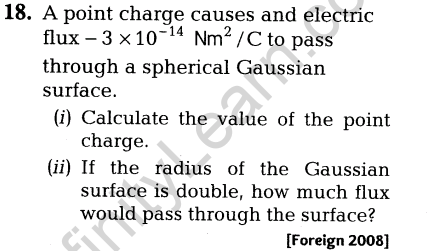
Ans.
3 Marks Questions
19.A hollow cylindrical box of lenght 1 m and area of cross-section 25 cm2 is placed in a three-dimensional coordinate system as shown in the figure.
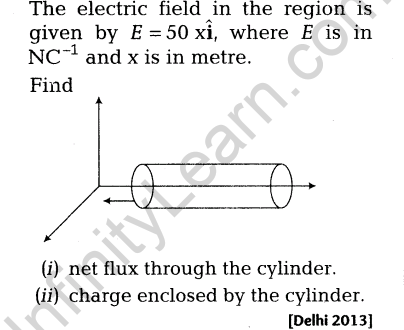
Ans.
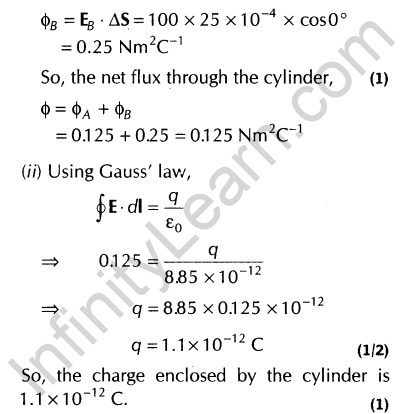
20.State Gauss’ law in electrostatics. A cube which each side a is kept in an electric field given by E = as shown in the figure, where C is a positive dimensional constant. Find out
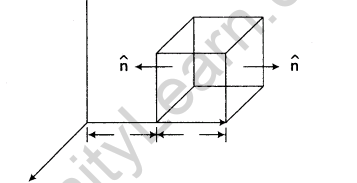
(i) the electric flux through the cube
(ii)the net charge inside the cube.[Foreign 2012]
Ans.
21. Using Gauss’ law, obtain the expression for the electric field due to uniformly charged spherical shell of radius R at a point outside the shell. Draw a graph showing the variation of electric field with r, for r > R and r < R.[All India 2011]
Ans. Let us consider charge +q is uniformly distributed over a spherical shell of radius R. Let £ is to be obtained at P lying outside of spherical shell.
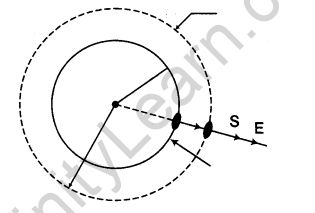
Eat any point is radially outward (if charge q is positive) and has same magnitude at all points which lie at the same distance r from centre of spherical shell such that r> R.
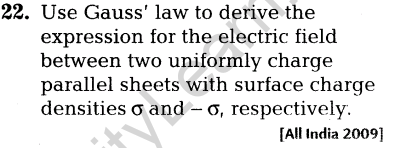
Ans.
23. State Gauss’ law in electrostatics. Using this law, derive an expression for the electric field due to a uniformly charged infinite plane Sheet. [Delhi 2009]
Ans.
Let us consider a large plane sheet of charge having surface charge density sigma

Ans. (i)
4 Marks Questions
25. Using Gauss’ law, deduce the expression for the electric field due to a uniformly charged spherical conducting shell of radius R at a point
(i)outside the shell
(ii)inside the shell
Plot a graph showing variation of electric field as a function of r > R and r < R.{r being the distance from the centre of the shell) [All India 2013]
Ans.
26. (i) Define electric flux. Write its SI unit.
(ii) A small metal sphere carrying charge + Q is located at the centre of a spherical cavity inside a large uncharged metallic spherical shell as shown in the figure.Use Gauss’ law to find the expressions for the electric field at points Pl and P2.

(iii)Draw the pattern of electric field lines in this arrangement.[Delhi 2012 C]
Ans.

(iii) The electric field lines due to arrangement is shown as below:
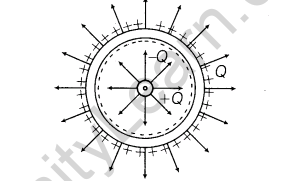
Charges will be uniformly distributed on all the surfaces hence, all field lines will be uniformly separated.
27.Define electric flux. Write its SI unit, (ii) Using Gauss’ law, prove that the electric field at a point due to a uniformly charged infinite plane sheet is independent of distance from it.
How is the field directed if
(a)the sheet is positively charged
(b)negatively charged? [Delhi 2012]
Ans. (i) Electric flux Electric flux over an area in an electric field represents the total number of electric lines of force crossing the area in a direction normal to the plane of the area. The SI unit of electric flux is N-m2/C
(ii)
Let us consider a large plane sheet of charge having surface charge density sigma
The field directed
- Normally away from the sheet when sheet is positively charged.
- Normally inward towards the sheet when plane sheet is negatively charged.
28. (i) State Gauss’ law. Use it to deduce the expression for the electric field due to a uniformly charged thin spherical shell at points
- inside the shell and
- outside the shell.
(ii) Two identical metallic spheres A and B having charges +40 and – 10O are kept a certain distance apart. A third identical uncharged sphere C is first placed in contact with sphere A and then with sphere B. Then, spheres A and Bare brought in contact and then separated. Find the charges on the spheres A and B.[All India 2011C]
Ans.(i) (ii)
29. (i) Define electric flux. Write its SI unit, (ii) The electric field components due to a charge inside the cube of side 0.1 m are shown below.
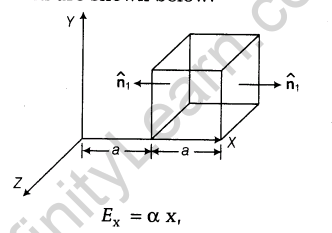
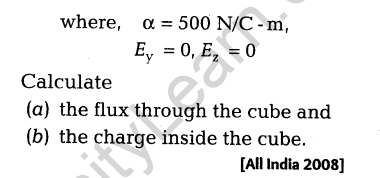
Ans. (i)Electric flux Electric flux over an area in an electric field represents the total number of electric lines of force crossing the area in a direction normal to the plane of the area. The SI unit of electric flux is N-m2/C
(ii) The electric field is directed along +X-axis. Therefore, angle between E and A for left face is 180°, whereas for right face is 0°. The angle between E and A on four non-shaded faces is 90°. Therefore, flux linked with these four faces is zero.

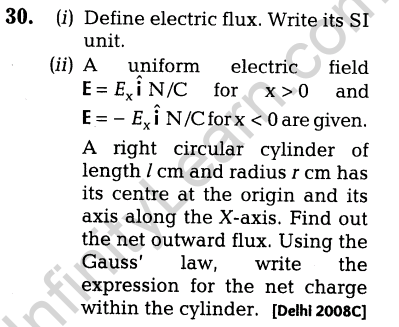
Ans. (i)Electric flux Electric flux over an area in an electric field represents the total number of electric lines of force crossing the area in a direction normal to the plane of the area. The SI unit of electric flux is N-m2/C
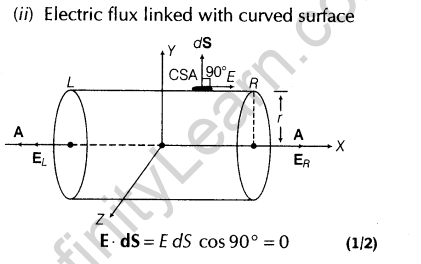
Ans. The electric lines of force emerge from the positive charge and comes into the negative charge.
(i)
Electric field lines due to positive and negative charged spherical shell are as given below in figures (a) and (b) I respectively
CBSE Class 12 Physics Gauss’s Law FAQs
What is Gauss's Law in Physics?
Gauss's Law describes the relationship between the electric flux through a closed surface and the electric charge enclosed within that surface. It’s a fundamental principle used to calculate electric fields in various symmetric situations.
Why is Gauss's Law important for CBSE Class 12 Physics?
Gauss's Law is crucial for understanding electric fields and flux, and it forms the basis for solving complex electrostatic problems in the CBSE Class 12 Physics syllabus. Mastery of this topic helps students tackle important questions effectively.
How is Gauss's Law applied to find the electric field?
Gauss's Law is applied by selecting an appropriate Gaussian surface where the symmetry of the problem simplifies the calculation of electric fields. It’s especially useful for spherical, cylindrical, and planar symmetries.
What types of questions on Gauss’s Law are important for exams?
Important questions on Gauss's Law for Class 12 include deriving expressions for electric fields using Gaussian surfaces, explaining the applications of Gauss's Law, and solving numerical problems involving electric flux and charge distribution.
Where can I find CBSE Class 12 Physics important questions on Gauss's Law?
You can find important questions on Gauss’s Law, along with detailed solutions and explanations, on the Infinity Learn page dedicated to CBSE Class 12 Physics study material, which covers all key concepts and practice problems.









